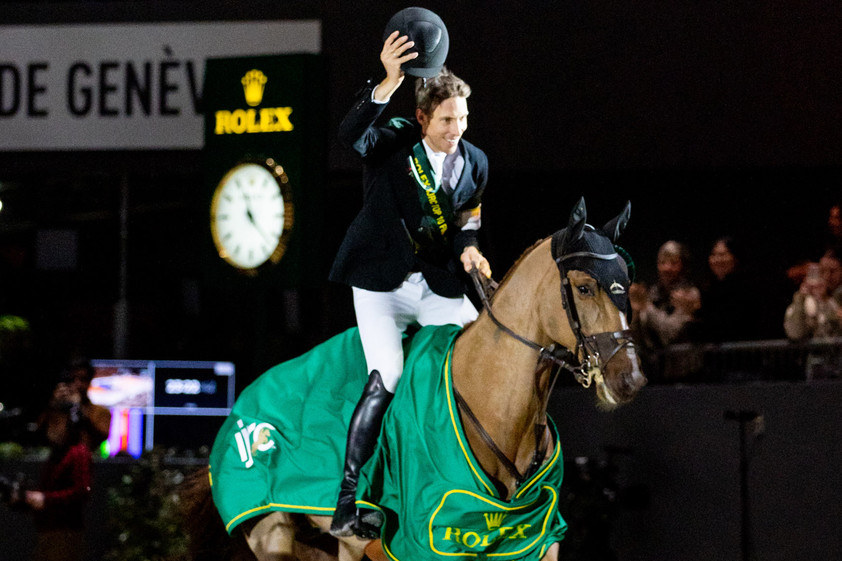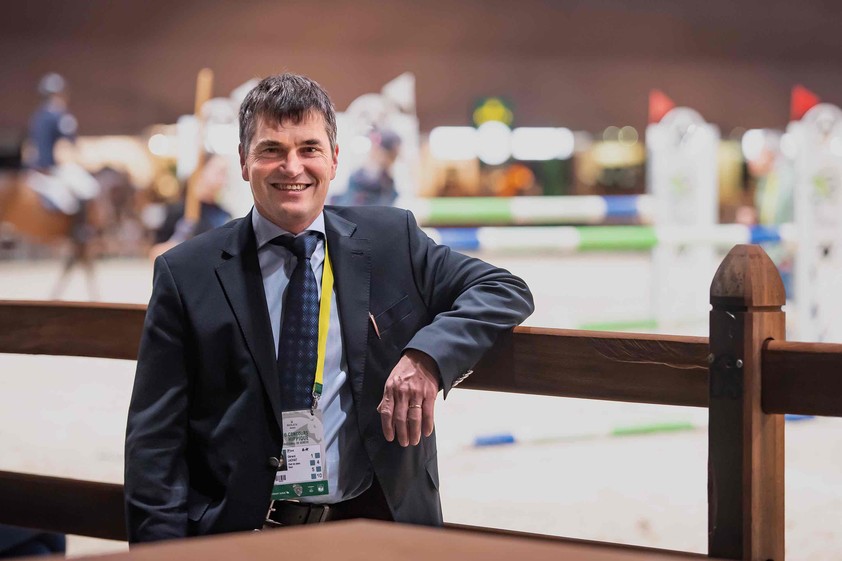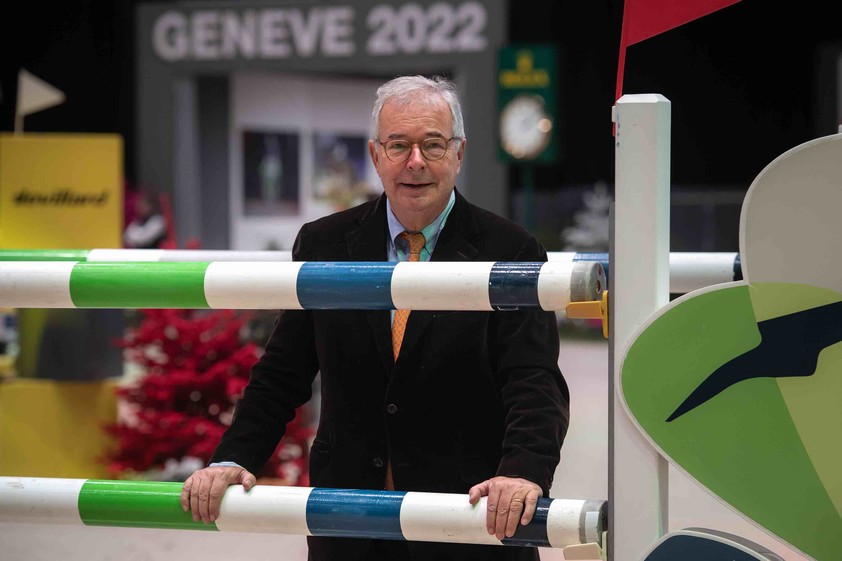Henrik Von Eckermann and King Edward win the Rolex IJRC Top 10 Final
A capacity crowd in the Palexpo’s Geneva Arena watched on in anticipation, as 10 of the world’s very best show jumpers and their equine partners battled it out for the honour to be crowned the 2022 Rolex IJRC Top 10 Final champion. Having qualified for this esteemed class, based on November’s FEI jumping rankings, the truly international line-up, comprising riders representing France, Sweden, Great Britain, The Netherlands, Switzerland, The USA and Brazil, would undoubtedly produce unrivalled levels of show jumping.
Just four riders managed to complete the first round of the Gerard Lachat-designed course without picking up a fault, including Thursday night’s winner of the Trophée de Genève, Marlon Modolo Zanotelli, current world number one, Henrik von Eckermann, and in-form riders, Simon Delestre and McLain Ward, with the Frenchman ultimately setting the fastest fault-free time of 65.90 seconds. While those with first round faults still found themselves in contention – particularly Peder Fredricson from Sweden with just one time penalty and Dutchman Harrie Smolders with one down – unfortunately, Ben Maher and Exit Remo had a night to forget, after the pair accrued 31 penalties.
On to the second round and everything was to play for. First to go, Great Britain’s Ben Maher found a small consolation after he and his 13-year-old bay gelding went clear. Local hero Martin Fuchs and Conner Jei were unable to apply any pressure after accruing 12 penalties, while Julien Epaillard and McLain Ward both put one down. Swede Peder Fredricson was able to set the early pace after going clear, thereby finishing with one point; however, his teammate, the inimitable Henrik von Eckermann, went one better, thereby becoming the first rider to go double clear with his superstar gelding, King Edward. The final two riders to go, Marlon Modolo Zanotelli and Simon Delestre, were determined to go one better still. But it wasn’t to be after the Brazilian’s mare hesitated and put the penultimate fence down and the Frenchman, while going double clear, just couldn’t find enough pace, crossing the line over nine tenths slower than von Eckermann, who was ultimately crowned champion of the 21st edition of this revered class, much to his delight.
Thrilled after going one better than last year and achieving a bucket list goal, Henrik von Eckermann, commented: “Yes, definitely – it was one of my focuses after the World Championships when I gave King Edward a bit of a rest, and wanted to build up slowly again, and this was one of the targets, absolutely. It has been a target for many years. Like I said when we had the Rolex IJRC Top 10 Final in Stockholm when Daniel Deusser won it; I walked the course and spoke to Eleonora [Ottaviani] and said one day I would like to win this one, so it’s a very special moment for me.”
Walking the course with:
Gérard Lachat
In your opinion, what makes CHI Geneva such a special competition?
The particular layout of the event makes CHI Geneva special; everything is under the same roof, which makes the riders’ accessibility easier. The show jumpers do not have to go outside, and they have easy access to their hotel nearby. This easy accessibility makes the riders value the competition in terms of logistics. As this is the Rolex Grand Slam, there are some amazing courses, and classes filled with ambitious riders, which raises the competition level. Due to the event being linked with Rolex, the event’s atmosphere becomes naturally prestigious. It is clear that there is a lot of money behind the event, and this adds to the riders’ motivation to take part.
What kind of course have you prepared for the Rolex Grand Prix on Sunday?
It is a fairly long course, similar to last year with 14 obstacles, including two doubles and a triple, making it a real Grand Prix course. We have created the CHI Geneva course differently compared to the Rolex Grand Slam courses in Aachen and Calgary, as for those there are two rounds and a jump-off. In Geneva, we do not make riders do two rounds, so it allows the course to be extended, to be slightly more difficult and to include a jump-off.
How many clear rounds are you expecting?
It's always more or less the same, we try to have eight or 10 without mistakes. If we have 12, it means that there are too many – if this does occur, it will be less than ideal. In general, we always try to have fewer than 12 but we are aiming for eight clears. This is the ideal number, but if there are six or even 10 then these would be fine, as well.
Which combination do you think has the best chance of winning the Rolex Grand Prix on Sunday?
A lot of the riders who compete in the Rolex Grand Prix at CHI Geneva have great performances. It is essential to have a horse that has skill and speed, and is overall in great shape. Another factor that affects a rider’s performance is whether they are personally fit on competition day. Everyone, even the best riders can have bad days. For example, we saw this with Ben Maher, who has won a lot of Grands Prix. I spoke to him yesterday and he said he hopes his luck lasts throughout the weekend. He is a good show jumper, as he views every situation and competition realistically, while weighing up his rivals. At the moment, he is on top form and he has horses that are on great form, as well.
There is always a rider who experiences periods of great form and victories. These riders are often the ones who are at the top of the rankings, such as Steve Guerdat, Martin Fuchs and Henrik von Eckermann. These riders have achieved incredible success recently. But all of a sudden there can be a relatively new rider, such as Julien Epaillard, who comes along; someone who has never been ranked number one in the world, who certainly has the ability to achieve this one day. There is a possibility that Julien does well this weekend if, for example, von Eckermann has a weak performance.
When did you design your first course as head course designer?
Unfortunately, I do not remember my very first course well, but I am certain that it was a small course. I would say it was around a 1,00m or a 1,10m event. However, I remember the first big competition I designed was in St. Gallen – all the pressure was on me. Unfortunately, we experienced terrible weather that weekend so only two events took place. A few weeks later, I gained some more experience and responsibility at CHI Geneva and it went relatively well.
Do you have any passions outside of the equestrian world? What do you do when you are not working?
Being fully transparent, I do not have much time to myself, as I still have my breeding centre that I take care of. We have a lot of foals, and young horses that require a lot of attention and patience when training them. At home, we also have foals that I take care of, so when I do have some free time, I tend to not do much to relax.
Have you ever been intrigued by a particular course?
In truth, I cannot decide on one course, as there have been so many that I have liked. For example, last year’s Rolex Grand Prix course at CHI Geneva was, in my opinion, the best Grand Prix course that I have ever designed. It was appreciated by the audience and the riders, and despite having an event during the pandemic, I was proud of the way it was designed.
On the other hand, there are a lot of courses designed by others that I like and that I think were successful. Again, I cannot make my mind up on one but I really enjoyed the one at this year’s World Championships in Herning. I went with Louis Konickx, as his assistant, and I enjoyed all the courses he designed for the World Championships.
I’ve seen several courses on TV, and I appreciated the Tokyo 2020 show jumping course. It was designed successfully – it was a very professional course that contained several difficulties, and several lines, which were technical. I was lucky enough to receive the plans and I can confirm that it was technical, it was interesting to see – it was a superb event.
Is there a course designer that has inspired you more than others?
It is hard to say whether there have been some who have inspired me more than others but there are definitely course designers that have guided me to my success today. For example, I was inspired and influenced by Rolf Lüdi, and in my career, I have had the chance to work with several designers and it has been very beneficial. Early on, I had the chance to work with Louis Konickx, and that was amazing, as we had the same approach and ideas regarding competition lines. The way we worked together was great – we were supportive of each other’s ideas but we also provided constructive feedback regarding our lines. We criticised each other in a constructive way, and at the end of the day we had the same goal to progress the sport. There was absolutely no tension working with him. I also had the chance to work twice with Uliano Vezzani; it was a different experience, as we have different approaches, and style in terms of the work, but he is an incredible person.
Word from the Organizer:
Alban Poudret
As Sport Director at CHI Geneva, please tell us about your role and your team
I have been Sport Director at CHI Geneva for the past 30 years. Before that, I was involved in the commentary team and did some other little jobs at the show. My role involves being responsible of both the sport, as well as the entertainment – this includes attractions, displays and the whole spectacle of the show. We have an incredible team – Sophie [Mottu Morel], Michel [Sorg] and I, we are great trio, and we discuss all of our ideas together. I pitch new ideas and how to fund them, then if we are happy we will present the ideas to the whole committee.
The committee is made up of 25 people, and then there is a sub-committee that is made up of 10 people, who are focused on equestrianism. The other 15 members are non-equestrians and are, for example, architects, finance or security specialists, who ensure the show is a success and runs as smoothly as possible.
The sub-committee meets regularly, and we all share our thoughts and opinions of the different concepts. It is a very democratic process, and we ensure that the majority agrees with the ideas before we implement them.
During the show, we have extra support from other people, such as Philippe Guerdat, who is the father of Steve. Philippe stopped his jumping career in 1996 and since then he has helped me behind-the-scenes at CHI Geneva. He speaks with the riders about the ground, their wishes and how we can improve things. There are so many people who help to make this show the success that it is today.
We heard you love your statistics – which are your favourite statistics from the last 30 years?
Yes, I love statistics and facts – I spend a lot of time collating them, especially historical facts and looking back at all of the different generations of the sport. For my magazine [Le Cavalier Romand], I have collated the medallists of all the different championships since 1912, as well as the winners of all the major Grands Prix of the last century. Ludger Beerbaum has won the most, with John Whitaker second, Rodrigo Pessoa third, Steve Guerdat fourth and Hans-Günter Winkler fifth – it is very interesting to compare and contrast different generations.
At CHI Geneva, we did not have a list of the champions of the major classes, so I created a record of all of the different winners. Steve Guerdat has won 12 major classes at CHI Geneva, including three Rolex Grands Prix and two Rolex IJRC Top 10 Finals. Rodrigo Pessoa has won 10 of the major classes and Kent Farrington nine.
This year we invited Francisco “Paco” Goyoaga Mollet, a U25 Spanish rider, to compete at CHI Geneva. He came to speak to me at CHIO Aachen, and he told me that his grandfather won the Grand Prix at CHI Geneva twice. In addition, he won the Trophée de Genève and the Nations Cup here – up until 1983 we were allowed to have Nations Cup competitions indoors, but since then in Europe they have to be held outdoors.
In your time working at CHI Geneva, how have you seen the quality of the sport positively develop?
I have to say it's changed incredibly. Thirty years ago, perhaps eight or ten riders could win the Grand Prix on Sunday, but these days 30 out of the 40 starters are in contention. It's not even guaranteed that the best riders will even qualify for the Rolex Grand Prix. It's remarkable how close the competition is nowadays, and I do wonder if it will continue to always be like this. The horses today are so good – this means you have to have an almost perfect horse to be in with a chance of winning. The riders' technique has also improved a lot, the size of the riders’ teams have grown, and overall everything is just so professional. So, sometimes I think where can we go next. In the end, I realise that the situation is fair, which in part is testament to the course designers, who are very clever, and they understand they have to push the riders and their horses, but only very delicately and gradually.
As organisers, we also have a responsibility for the evolution of the sport; for example, to ensure we keep the door open to allow future show jumping talent to compete and develop. We are proud to have invited Victor Bettendorf from Luxembourg, who has had so many 4* Grands Prix victories, but has not had the chance to ride in the 5* shows and last night he was second in the Trophée de Genève!
We have a lot of offers from riders to pay to participate at CHI Geneva, but we are determined to always refuse, to keep our values and our philosophy, which is to ensure that the most talented athletes compete here and not just those who are able to pay. As organisers, we have a big responsibility to safeguard the evolution of the sport.
What is your personal highlight of CHI Geneva?
We have had so many amazing moments. Steve’s [Guerdat] first win in the Grand Prix here in 2006 was incredibly special. He won with Jalisca Solier, who he had only had since September 2006 and had never jumped in a 5* Grand Prix before. The day he got the horse, he rang me and said that he thought with that mare he could win the Grand Prix at CHI Geneva and go to the Beijing 2008 Olympics (Hong Kong) – and he did both. Since then, Steve has won CHI Geneva’s Rolex Grand Prix twice and the Rolex IJRC Top 10 Final twice, but I think his first win was the most emotional.
Another highlight for me was watching the incredible Martin Fuchs win the Rolex Grand Prix last year to make it a historic two wins in a row. This year I am really looking forward to Sunday for the incredible Clooney’s [51] retirement ceremony.
Last year we introduced the indoor cross-country, where Swiss rider Robin Godel won the class. He had a really tough year, as he sadly lost his horse during the cross-country phase of the Tokyo 2020 Olympics. It was really nice that he was able to end his year on a high and go into 2022 with a positive mindset.
Next year marks 10 years since the launch of the Rolex Grand Slam of Show Jumping; what has been your favourite memory?
I have two favourite memories. Firstly, it was incredible to watch Nick Skelton and Big Star win the Rolex Grand Prix at CHIO Aachen. It was one of the most magical horse and rider combinations, and to have them win the first Rolex Grand Prix, as part of the Rolex Grand Slam of Show Jumping at CHIO Aachen was such a special occasion. Then, watching Scott Brash and Hello Sanctos win three Majors in a row was phenomenal, particularly as we thought we would have to wait 20 or 30 years or even more to see someone accomplish this incredible feat. We knew our concept was victorious, not only Scott!



